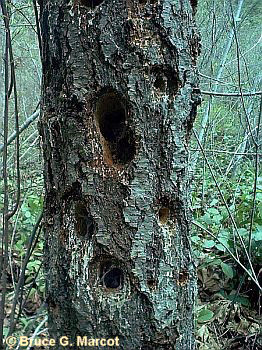 |
|
Pileated Signs |
|
|
Click on the image for a larger version
 |
|
Pileated Signs |
|
Cavities in a Douglas-fir tree created by Pileated Woodpecker (Dryocopus pileatus) |
Credit & Copyright: Dr. Bruce G. Marcot
| Explanation:
What vandal created these cavities in a
Douglas-fir
(Pseudotsuga menziesii) tree on Vancouver Island, Canada? Why,
that was no vandal, that was a Pileated
Woodpecker ... the largest living woodpecker in North America.
Pileated Woodpeckers create these very distinctive large, oval-shaped cavities as nesting sites, often in snags or dead trees. They also excavate trees for their beetle prey, and hammer on resonant wood as part of the pair-bond and territorial rituals. In turn, these cavities serve as entry sites for a wide array of other organisms -- including fungi, wood-boring insects, and a large array of secondary cavity-users such as small owls. In this way, Pileated Woodpeckers are viewed as keystone species and "ecosystem engineers" ... their creation of cavities directly affects the distribution and abundance of many other organisms in the ecosystem. This Douglas-fir occurs in some of the remaining older forests of Vancouver Island. |
Next week's picture: Rare Parakeet at the End of the Earth
Member Theme of Taos-Telecommunity